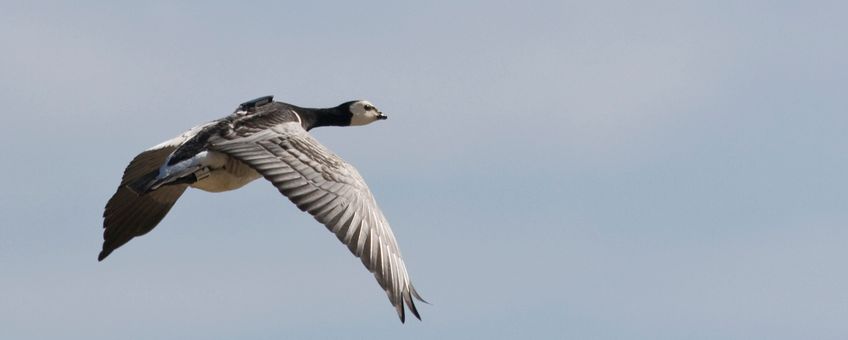
Arctic geese speed up their migration but still face global warming trouble
Netherlands Institute of Ecology (NIOO-KNAW)Fewer barnacle goose chicks survive long enough to leave their mothers' sides, according to a team led by NIOO-researchers Thomas Lameris and Bart Nolet. That's because the chicks hatch too late to take advantage of early spring foraging opportunities, they write in the latest issue of Current Biology.
Warming in the Arctic is proceeding much more rapidly than elsewhere. When spring arrives early, so does the annual peak in food quality. In years with a large mismatch between the time that the goslings hatch and peak food quality, fewer goslings survive in the month after hatching.
Leap in the dark
 The barnacle geese's wintering grounds are in the temperate zone, and the weather systems in those areas are not linked to those in the Arctic. "So when they're still in their wintering grounds, the birds can't predict whether it's going to be an early spring in the Arctic", says Bart Nolet. When they start their migration "they are leaping in the dark."
The barnacle geese's wintering grounds are in the temperate zone, and the weather systems in those areas are not linked to those in the Arctic. "So when they're still in their wintering grounds, the birds can't predict whether it's going to be an early spring in the Arctic", says Bart Nolet. When they start their migration "they are leaping in the dark."
It's only halfway through their journey that the geese are able to judge from environmental cues what spring up in the Arctic will be like. Their response is an accelerated marathon flight, skipping stops along the way in order to arrive as early as possible.
But according to the researchers, the evidence shows that egg laying has advanced much less than the birds’ arrival in the Arctic, seriously reducing the advantage that speeding up their journey could give them. That's because after their arrival, the geese must first take time to 'refuel' their own bodies before laying eggs.
Birds in trouble
The geese travel every spring from their wintering grounds along the North Sea coast via stopover sites along the Baltic Sea and Barents Sea to their breeding grounds in the Russian Arctic.
In order to analyse the impact of climate change on their breeding times, Lameris and Nolet combined remote sensing, bird tracking, stable isotope techniques, and field observations along the birds’ entire flyway. Financial support was provided by the Netherlands Organisation for Scientific Research's Polar Programme.
The findings of the study suggest that unless the birds start heading north earlier in the year - rather than just speeding up their travel along the way - they are in trouble. But that may be difficult.
Rapid adjustment
Currently, says Nolet, barnacle geese most likely rely heavily on cues such as day length, which don't change with the temperature rise. Other cues on which they may depend, including the greening of vegetation, don't show the same rapid advance in the temperate regions as they do in the Arctic.
So whether the geese can adapt their cue sensitivity and match their migration timing to changing climatic conditions remains uncertain. But there are signs that they may be flexible enough to adjust by other means: according to Nolet, some barnacle geese have recently given up migration altogether, breeding instead in the temperate areas.
“Geese migrate in families, and young learn the route and timing from their parents,” says Nolet. “On the one hand, this leads to traditional patterns; on the other hand, it can lead to rapid adjustments when some birds experience that doing the migration differently - often induced by extreme weather events - pays off.”
Text: Current Biology / NIOO-KNAW
Photo: Jasper Koster (lead photo: Barnacle goose with UvA-BiTS logger on its back)
